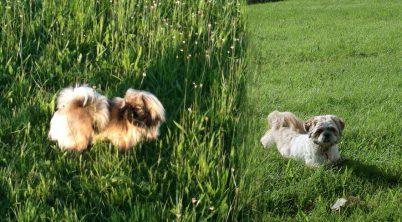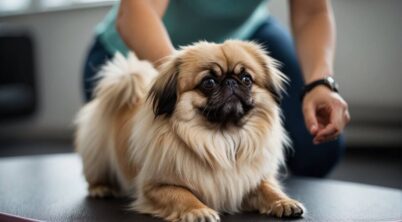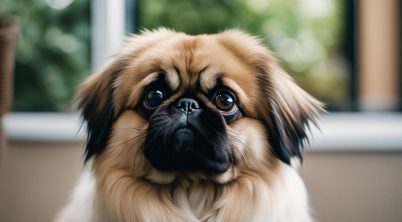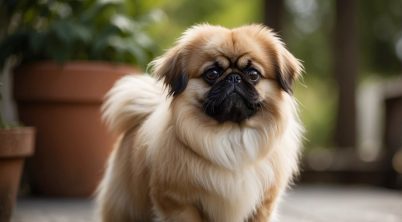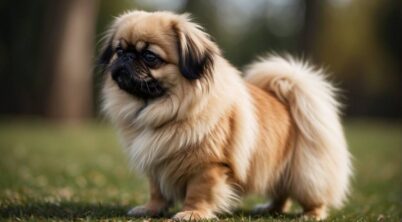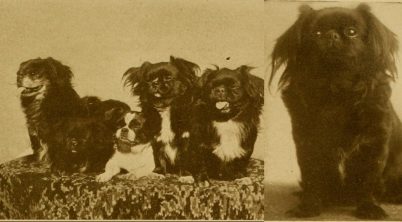The Pekingese, a toy dog breed hailing from ancient China, is admired for its long, flowing coat and distinctive “lion’s mane.” Displaying a strong sense of self-esteem and individuality, this breed can be a joy to have as a companion. In terms of health, Pekingese dogs can lead a content life with proper care and regular veterinary checkups. They commonly enjoy a lifespan of 12 to 14 years, which is a testament to their overall robustness as a breed.
However, potential owners should be aware that the Pekingese are not devoid of health challenges. They are predisposed to certain conditions, such as heart disease, which can be influenced by genetics, lifestyle, and their unique physical build. Their lush coat requires diligent grooming, and their small stature comes with a specific set of needs in terms of diet and exercise to prevent obesity—a contributing factor to various health problems.
Owners should prioritize early socialization and consistent training to address behavioral tendencies like stubbornness or excessive barking. Staying vigilant about their health and wellness routine is crucial in managing and mitigating the breed’s health risks, ensuring that these dignified dogs remain as healthy as possible throughout their lives.
Table of Contents
Health and Wellness
Pekingese dogs, known for their long, luxurious coats and charming demeanor, have distinct healthcare needs that potential and current owners must be aware of. This section examines the breed’s common health concerns, breed-specific issues, and the preventative measures that can help ensure their health and well-being.
Common Health Concerns
- Breathing Problems: As a brachycephalic breed, Pekingese have a shorter skull shape, which often leads to breathing difficulties. Owners might notice snoring, sneezing, or more serious respiratory conditions that require veterinary attention.
- Progressive Retinal Atrophy (PRA): This degenerative eye disorder can lead to blindness. It is essential to monitor the Pekingese’s eyesight throughout its life.
- Grooming Maintenance: Their long coat necessitates regular grooming. Without frequent brushing and baths, a Pekingese may develop skin conditions due to matting and unhygienic fur.
Breed-Specific Issues
- Heat Sensitivity: Their flat faces make Pekingese particularly susceptible to heatstroke. Owners should ensure they are kept in cooler environments during hot weather.
- Dental Issues: Due to their compact jaw, Pekingese may experience crowding of teeth, leading to dental problems. Regular dental check-ups are recommended.
- Skeletal and Joint Problems: Some Pekingese may have a genetic predisposition to deformed bones and joints, which can affect mobility and cause pain.
Preventative Measures
- Responsible Breeding: Prospective owners should choose a reputable breeder who screens for common health problems in the puppies.
- Vaccinations and Check-Ups: Routine vaccinations and veterinary check-ups are crucial for early detection and prevention of health issues in both puppies and adult dogs.
- Diet and Exercise: A balanced diet and regular, gentle exercise can help prevent obesity, which exacerbates many health problems in Pekingese.
By understanding and addressing these health concerns and taking preventative measures, Pekingese owners can help their pets enjoy a healthier, happier life.
Physical Attributes and Breed Standards
The Pekingese, a toy breed known for its compact and sturdy physique, exemplifies certain distinctive physical attributes that adhere to breed standards set for their classification. Adult Pekingese typically weigh between 7-12 lbs, a size that aligns with their categorization as a toy breed. However, while small, they boast a substantial build.
In terms of height, a Pekingese stands approximately 6-9 inches at the withers. This breed is characterized by its notably thick coat which can display a variety of colors such as black, white, cream, tan, red, and gray. The coat, while majestic, does require regular grooming due to its length and tendency for shedding.
- Weight: 7-12 lbs
- Height: 6-9 inches at the withers
- Coat Type: Thick, long
- Common Colors: Black, White, Cream, Tan, Red, Gray
They possess a bold and lion-like appearance attributed to their abundant mane. This feature demands attention and maintenance to prevent matting. Breed standards recognize their slightly pushed-in face or brachycephalic head which requires examining for any potential respiratory issues.
The Pekingese moves with a confident, rolling gait that echoes its regal origins. They are surprisingly robust for their size, reflecting a well-balanced and muscular frame. Breed enthusiasts value the Pekingese for their overall impression of dignity and importance, a sentiment immortalized within breed hallmarks. These dogs continue to charm admirers with both their physical splendor and spirited disposition.
Temperament and Behavior
The Pekingese is known for its dignified persona and self-assured confidence, which echo its noble Chinese ancestry. Traditionally held in high regard within Chinese royalty, these dogs carry themselves with a regal bearing and possess a distinctive self-importance that is evident in their demeanor.
In terms of personality, they are fiercely independent and can be quite stubborn at times, making training a Pekingese a task that requires patience and consistency. Their strong-willed nature must be met with firm yet gentle guidance to instill obedience.
These toy dogs form strong bonds and exhibit significant loyalty to their owners, often becoming deeply affectionate companions. They thrive on attention and can be protective of their family, which paired with their acute alertness, makes them excellent watchdogs.
Despite their small stature, the Pekingese boasts a notable intelligence. The American Kennel Club describes the breed as “sophisticated dogs of distinction,” capable of quick learning but also inclined to make their own decisions about whether or not to obey a command.
Pekingese were once known as “Sleeve Dogs” because members of the imperial court would carry them in the voluminous sleeves of their robes. This historical context accentuates their legacy as cherished and esteemed pets well-suited to indoor living and companionship.
Their behavior is marked by a calm but observant nature, with a tendency to bark to alert their owners—another facet of their inherent watchdog capabilities. Careful socialization from a young age can help temper their territorial instincts and promote a well-rounded temperament.
Ownership and Care
Owning a Pekingese comes with both joys and challenges. Recognized for their alert nature and sophisticated demeanor, these dogs were once companions to the ruling classes of ancient China. In modern households, they fit well due to their independent traits and adaptability to living in apartments. Ideally suited for families or individuals, Pekingese are considered small dogs, with a stocky body shape and muscular bodies, weighing up to 14 pounds.
The Pekingese has a squashed face which is attributed to their brachycephalic breed characteristics. Due to this, owners should be mindful of respiratory issues and overheating. Regular veterinary check-ups are essential to maintain their health.
A typical Pekingese displays a distinctive rolling gait when it walks—an ode to its unique physical structure. When it comes to exercise, moderation is key; these dogs require a low amount of daily activity to remain fit. Despite their size and calm demeanor, they can be effective watchdogs, often alert and wary of strangers.
Training a Pekingese can be a test of patience owing to their natural stubbornness. They require a consistent approach to training, benefiting from sessions that respect their sensitive nature. Dog training centers often provide the structure needed for their education. Pekingese training should reinforce Pekingese personality and temperament, which tends toward independence and loyalty.
Here’s a guide covering various aspects of Pekingese care:
Grooming:
- Shed Seasonally: Brush their coats regularly to manage shedding
- Trimming: Some owners prefer a shorter trim for easier maintenance
Accommodation:
- Suitable for apartments due to their size and exercise needs
- Quiet environments where their watchdog tendencies won’t cause issues
Health:
- Monitor for signs of breathing difficulties
- Keep them cool to prevent overheating
Prospective owners should consider adopting from an animal shelter or rescue group, where many Pekingese await homes. Prior to adoption, consult a researcher, dog trainer, or dog breed consultant to understand the breed’s needs thoroughly.


